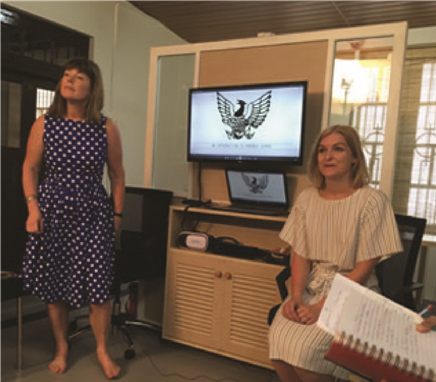Director’s Message
World Autism Awareness Day, celebrated on April 2, is a good opportunity to educate people around the globe on autism, to honour every autistic individual for who they are and ensure acceptance of autistic individuals. Such efforts should not be confined to a single-day. Instead, it should be part of day-to-day life. CADRRE’s International Autism Conference in August will aim at spreading awareness to build an inclusive world. Acceptance and inclusion are the keys for a society to progress.
– G. Vijaya Raghavan, Hon. Director CADRRE
To register for the conference please go to: cadrre.org

Veronica Armson and Kate Daintith at CADRRE
SPEAKING PICTURES
Communicating through pictures has existed since the time of our stone age ancestors who employed pictures not only to decorate their walls but also for
didactic purposes. Simplistic line drawings scratched onto rocky surfaces or drawn into the mud were used to communicate at a time when spoken languages didn’t exist. This is the same principle employed for Picture Exchange Communication System (PECS), a method used to encourage communication in autistic children,
especially those who are non-verbal, through the use of pictures to elicit answers from them.
Veronica Armson, Associate Head Teacher, and Kate Daintith, Specialist Literacy Teacher, from Phoenix School, London, which does some exemplary work in the field of autism, were at CADRRE to educate and train staff
members about the benefits of PECS. PECS is a method of identifying an object or activity the child enjoys and then using pictures corresponding to the object or activity to encourage them to point out or communicate what he / she would prefer. As the child figures out the logic behind PECS he / she would point out to the picture or sometimes even voice aloud inconspicuously their preference.
Although this method is most commonly used for children on the spectrum, it is also used for children with other cognitive and communication challenges.
Veronica and Kate demonstrated the advantages of PECS for children on the spectrum, especially those who are non-verbal or reluctant speakers. They threw light on how visual time tables and algorithms could be used to encourage the child to follow a routine or pick up a skill by following visual cues. Being affirmative and pleasantly expressive is essential for professionals working with PECS.
Applied Behaviour Analysis Workshop at CADRRE

Applied Behaviour Analysis (ABA), a much-debated methodology, has an edge over other therapies because it is a holistic, scientifically authenticated approach and a scale to gauge in detail the progress of a child. However, its occasional aggressive character does raise a lot of eyebrows.
Passionate and enthusiastic Meera Ramani, Founder & Director of Behaviour Enrichment in UAE, which focuses on ABA-focused speech and behaviour intervention for intellectually challenged children, dispelled a lot of myths surrounding ABA during her session at CADRRE. She was accompanied by Rajashree Balasubramanian, Operations Head at Behaviour Enrichment.
Touching upon the basics of ABA, she underlined how ABA relied on data, which is collected rigorously during each class. The data is compiled and analysed to study the progress of a child. She reiterated how ABA practitioners had to practise to be swift with their hands and questions and be thorough with the technique before working with the children. During the interactive session, all participants had an opportunity to take part in role play and try their hand at teaching ABA.
The session was attended by professionals from the Government Ayurveda College, Sri Dhanwanthari Clinic, Trivandrum International School, NISH, Sree Chitra Tirunal Institute for Medical Sciences and Technology and the CADRRE staff members.
In conversation with…
Matthew Savage

CADRRE caught up with Matt Savage, an autistic savant musician, on his journey as a musician, a teacher and an individual with autism. He is also a speaker at the upcoming International Autism Conference. Edited excerpts from the interview.
How did you develop a passion for music? I read that, as a child, you had an aversion to loud sounds and beats. Today you are a musician and working on
improvisations of jazz. How did the transformation take place?
It was a therapeutic transformation – the therapy that helped most was Auditory Integration Therapy (AIT), which is a sound desensitization treatment. I started AIT at theage of 6, but I underwent many therapies in total, from the age of 3 to the age of 8. My aversion to sounds was not totally all-encompassing, but it applied to most hours of the day, so my parents’ house had to be quiet. Learning the piano came naturally, thanks to a toy xylophone “piano” (with keys) in the basement of the house. This helped me to visualize things. My parents showed me the “real” piano the same day, and I started piano lessons the same week.
How did you develop a passion for jazz and who is your inspiration in music?
The first jazz album I ever heard was Miles Davis’ “Kind of Blue.” And I remember that the first thing that excited me was the fact that the average length of a song was nine minutes. I liked big numbers as a little kid and couldn’t believe that one could improvise so quickly and for so long. But it took me a little while to become attached to this particular musical genre over others. I think the big epiphany for me came when I studied jazz for the first time, and learned to [do] solo. Jazz solos, for me, are an extension of the tune’s melody, not merely a separate section.
In what way did your mother and teachers help you tune you into the world of music?
They really helped me learn to interact with a jazz group, and to help figure out the social cues required for a performance. Later on, I studied with the late jazz educator Charlie Banacos. He taught moral and life lessons with each piano lesson and helped me to decide the future of my career and open up my
musical mind. And I also can’t thank my mother, Diane, enough for traveling with me and making the complex media landscape less daunting – it is an intense life indeed as a musician.
You teach music to children with autism. Considering you were autistic yourself, do you think you have been able to form a special bond with any of your students?
What I have learned is that eye contact and body language are essential, even for “special needs” kids who might not perceive that immediately… the only difference is that stronger cues are required. And, sometimes, it is necessary to point at a musical note multiple times instead of just once. A lot of times, the nature of a music lesson is simply a question of attention and tempo (speed) – regardless of whatever condition a student might have. The exciting and movement-oriented design of musical instruments helps make every one-on-one lesson special, no matter who the student may be.
Do you think music helps unlock supressed areas in a person with autism? Could you share your perspective on it from a personal point of view and as a musician who teaches others?
Certainly, there are many people who have learned to sing before learning to speak. And lots of people I know have perfect pitch, which means that one can identify a musical note without hearing a reference note first. Having a mathematical understanding of the music can help one understand the nuances of speech in a similar way – I would say that this has happened to me, as I have perfect pitch as well.
Do you face any special challenges being a musician?
The entertainment industry is very publicity-oriented, and it is very hard for me to recognize faces – I need to put in lots of energy to be able to maintain attention for such a long time. Also, every musician romanticizes the cheap pizza and ramen diet, but that doesn’t work for me since I have a gluten allergy (which fortunately is not severe)!
What is the way forward for your career?
Last fall, I started a college teaching position for the first time, at Bunker Hill Community College in Boston. I am looking forward to continuing this career in higher education in addition to my touring. Besides teaching piano, I now have a jazz-funk fusion group (Matt Savage Groove Experiment) and am focusing more on jazz and classical composition. There are many different sounds that one can create when writing for different instruments.
Are you familiar with Indian music or musicians? Would you be interested in crossover projects?
I wish I knew more names in Indian music, but I am very familiar with concepts such as ragas, talas and tihais, thanks to my studies with tabla player Samir Chatterjee at Manhattan School of Music. I played in his Music of India ensemble, which combines jazz with the complex polyrhythms of Indian classical music. I would love to do another project like this in the future.
What do you feel about coming to India?
I have always wanted to go to India and know many people who have taught there. This is an exciting opportunity. And I hope I can use this special trip to help reach out to music students, as well as parents who may have questions about starting a music career for their kids.
What is your message to parents of children with autism?
I want to help show both the parents and the children that anything is possible, and that it is wonderful to encourage kids to follow their passions – which can develop over many years and turn into a career.
Tips for parents
Pet pals
Pets can have a profound effect in the lives of children on the autism spectrum. Studies have shown they increase social behaviours, emotional reciprocity, decrease stress levels, improve verbal and non-verbal communication skills, help foster trust, teach responsibility and boundary-setting to children and adults alike. If you are a parent of a child on the autism spectrum and have a furry family member who probably already shares a bond with the child, you could consult an animal assisted psychotherapist who could help enhance this relationship to the benefit of your child.
For example, petting (tactile stimulation) them, brushing them, playing fetch, walking them on a leash, teaching commands and trying to match their pace of breathing are all different methods certified animal therapists use. However, it is imperative to not try this at home without proper understanding of your pet’s temperament and your child’s affinity towards the pet.
Anjana Thampy, Animal Assisted Psychotherapist, Chennai
Art Corner

Thought for the month
“From my clinical experience, I consider that children and adults with Asperger’s Syndrome have a different, not defective, way of thinking.”
Tony Attwood, psychologist and speaker based in Queensland, Australia